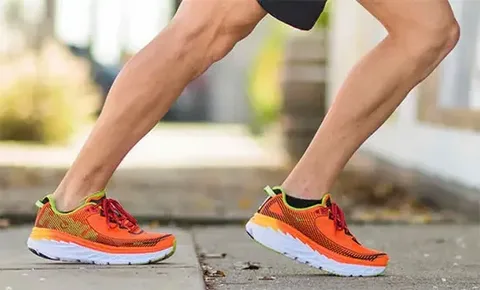Do you suffer from heel spurs? You’re not alone! Heel spurs can cause a lot of pain, especially when running. But the good news is that there are running shoes designed specifically to provide the support and comfort you need to keep the pain away. In this blog post, we’ll explore the best running shoes for heel spurs, so you can find the perfect fit and step out in comfort.
Understanding Heel Spurs and Their Impact on Running
Heel spurs, or calcaneal spurs, are bony growths on the heel bone’s bottom. They are often associated with conditions such as plantar fasciitis and Achilles tendonitis. Heel spurs can cause severe pain and discomfort, especially when running or engaging in high-impact activities.
The impact of heel spurs on running can be significant. When you run, the repetitive motion and the force exerted on your feet can aggravate the already sensitive area affected by the spurs. This can increase pain and discomfort, making it difficult to enjoy your running routine.
Heel spurs can also affect your running gait and biomechanics. The pain can cause you to alter your stride or foot strike, which can result in imbalances and inefficiencies in your running form. Over time, these changes can lead to additional injuries and problems in other areas of your feet, ankles, knees, and even hips.
It’s important to understand the impact of heel spurs on your running to choose the appropriate running shoes that can provide the necessary support and cushioning. The right shoes can help alleviate pain, reduce stress on the affected area, and improve your overall running experience.
Features to Look For In Best Shoes for Heel Spurs
When choosing the best shoes for heel spurs, there are several key features to look for that can help provide the support and comfort needed to alleviate pain and discomfort.
Firstly, it is important to look for shoes with excellent cushioning. Heel spurs can cause increased pressure on the affected area, so having ample cushioning in the heel can help absorb shock and reduce the impact on the foot. Look for shoes with a thick midsole and a well-padded heel collar.
Next, consider the stability of the shoe. Heel spurs can affect your running gait, so finding a shoe with good stability can help promote proper alignment and prevent further stress on the affected area. Look for shoes with a supportive arch and a firm midsole that helps control pronation.
Additionally, consider the flexibility of the shoe. Too much rigidity can cause discomfort, so finding a shoe that allows for natural foot movement is important. Look for shoes with a flexible outsole that bends with your foot.
Lastly, consider the fit of the shoe. Look for shoes that provide a secure and snug fit without any pressure points. Consider shoes with a roomy toe box to prevent rubbing and discomfort.
Considering these features, you can find the best running shoes that provide the support, cushioning, and comfort needed to keep you pain-free and enjoy your runs.
Neutral vs. Stability Shoes: Choosing the Best Shoes for Heel Spurs and Achilles Tendonitis
When choosing the best shoes for heel spurs and Achilles tendonitis, understanding the difference between neutral and stability shoes is crucial.
Neutral shoes are designed for runners with a neutral gait, meaning their feet do not roll excessively inward or outward while running. These shoes offer a balance of cushioning and flexibility, providing a natural and comfortable ride. They are generally recommended for runners with normal to high arches.
On the other hand, stability shoes are designed to provide additional support and stability to runners who overpronate, which means their feet roll excessively inward when running. These shoes typically feature a firmer midsole and a supportive arch to help correct overpronation and promote proper alignment. They are recommended for runners with low to flat arches.
Regarding heel spurs and Achilles tendonitis, neutral and stability shoes can be suitable options, depending on the individual’s specific needs and foot mechanics. If your heel spurs or Achilles tendonitis result from overpronation, stability shoes can provide the necessary support to prevent further stress on the affected area. However, if your foot mechanics are normal and you do not overpronate, neutral shoes with excellent cushioning can still provide the comfort and support needed to alleviate pain and discomfort.
Wide Width Options: Ensuring a Comfortable Fit For Heel Spurs
Finding the right running shoes can be challenging if you have wide feet. But when you have heel spurs, finding shoes that provide a comfortable fit becomes even more important. Thankfully, there are wide-width options available that can ensure you find the perfect fit for your heel spurs.
When searching for wide-width options, look for shoes that mention “wide” or “extra-wide” in their sizing options. These shoes are designed to accommodate wider feet and provide the necessary space to prevent any rubbing or discomfort on the affected area.
In addition to wide-width options, consider shoes with adjustable features such as laces or straps. This allows you to customize the shoe’s fit and ensure a secure and comfortable feel. Look for shoes with a roomy toe box, which can prevent crowding or pressure points on your toes.
Finding the right fit is crucial for managing heel spurs and preventing further pain or discomfort. Take the time to try on different wide-width options and walk or run around to ensure they provide the necessary support and cushioning for your heel spurs.
Incorporating Orthotic Inserts: Customized Support for Heel Spurs
When dealing with heel spurs, finding the right running shoes is essential. But sometimes, even the best shoes may not provide enough support and cushioning for your specific needs. That’s where orthotic inserts come in. Orthotic inserts are customized shoe inserts that can provide additional support, cushioning, and stability for your feet.
Orthotic inserts can be particularly beneficial for heel spurs because they can help redistribute pressure away from the affected area, reduce pain, and promote proper alignment. These inserts are typically made of foam or gel and can be placed directly inside your running shoes.
When incorporating orthotic inserts for heel spurs, choosing inserts specifically designed for your condition is important. Custom-made orthotics are often recommended because they are molded to fit the contours of your feet, providing optimal support and comfort. However, over-the-counter inserts can be effective, especially if designed for heel spurs or similar foot conditions.
Heel Spur Exercises and Stretches: Complementing Your Footwear
Heel spur exercises and stretches can complement your choice of footwear when dealing with heel spurs. These exercises and stretches can help strengthen the muscles in your feet and lower legs, improve flexibility, and alleviate pain and discomfort.
One effective exercise for heel spurs is calf raises. Stand with your feet hip-width apart, then slowly rise onto your toes, lifting your heels off the ground. Hold the position for a few seconds, then lower your heels. Repeat this exercise 10 to 15 times, working up to three sets.
Stretching exercises can also help relieve tension and tightness in the calves and plantar fascia. One effective stretch is the calf stretch. Stand facing a wall and place your hands on the wall for support. Step one foot back, keeping your heel on the ground and your leg straight. Lean forward slightly, feeling a stretch in your calf. Hold the stretch for 30 seconds, and then switch legs.
Another beneficial stretch is the towel stretch. Sit on the edge of a chair with one leg extended in front of you. Place a towel around the ball of your foot and gently pull back on the towel, stretching your calf and the bottom of your foot. Hold the stretch for 30 seconds, and then switch legs.
Incorporating these exercises and stretches into your routine can help improve flexibility, reduce pain, and enhance the effectiveness of your chosen running shoes for heel spurs. Remember to consult with a healthcare professional before starting any new exercise program.
Best Shoes for Heel Spurs And Plantar Fasciitis Prevent Falls
Regarding heel spurs and plantar fasciitis, finding the best shoes for heel spurs and plantar fasciitis can make all the difference in preventing falls and ensuring stability while walking or running. Heel spurs and plantar fasciitis can cause pain, inflammation, and discomfort in the heel area, making it difficult to maintain balance and stability.
To prevent falls and provide added support, choosing shoes with specific features is essential. Look for shoes with excellent arch support to help distribute weight evenly and relieve pressure on the affected area. Shoes with a cushioned insole and shock-absorbing midsole can provide added comfort and reduce the impact on the heel.
Additionally, shoes with a firm heel counter can help stabilize the foot and prevent excessive movement, reducing the risk of falling or tripping. A wide toe box is also important as it allows your toes to spread naturally and maintains proper balance.
When choosing the best heel spurs and plantar fasciitis shoes, consider options with a slip-resistant outsole to provide traction and grip on various surfaces. This feature is especially important if you plan to wear the shoes in wet or slippery conditions.
FAQs
1. Can best running shoes for heel spurs alone cure?
Running shoes alone cannot cure heel spurs. While the right shoes can provide support and cushioning to alleviate pain and discomfort, they do not address the underlying cause of the heel spurs. It’s important to consult with a healthcare professional, such as a podiatrist, who can diagnose properly and recommend a comprehensive treatment plan. This may include stretching exercises, orthotic inserts, physical therapy, other interventions, and wearing appropriate running shoes.
2. How long does it take for heel spurs to heal?
The healing time for heel spurs can vary depending on the severity of the condition and the treatment approach. Occasionally, heel spurs may resolve independently with conservative measures such as rest, ice, stretching exercises, and wearing proper footwear. However, if the pain persists or worsens, it is recommended to seek medical attention. Treatment options such as orthotic inserts, physical therapy, or corticosteroid injections may be necessary to help alleviate the symptoms and promote healing. It’s important to follow the advice of a healthcare professional and allow for adequate healing time, which can range from a few weeks to several months.
Conclusion
In conclusion, finding the best running shoes ensures a pain-free running experience. Heel spurs can cause severe discomfort and impact your running gait, but with the right shoes, you can alleviate pain, reduce stress on the affected area, and improve your overall running form. With the right shoes, support, and management, you can continue to enjoy running while minimizing the risk of further damage and complications. So don’t let heel spurs hold you back, find the perfect pair of running shoes and step out in comfort.
| Other Good Articles to Read |
| Skank Blogs |
| Unreal Blogs |
| Tba Blogs |
| All City Forums |
| Dany Blogs |
| Refuge Blogs |
| The Music Blogs |
| Key Forums |
| Joe Blogs |
| Blogs 4 Me |
| Blogs Emon |

